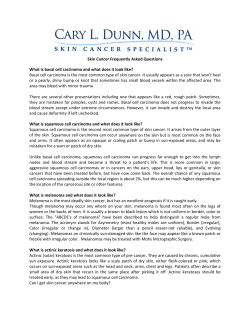
AK Actinic (Solar) Keratosis
PCDS Guidelines AK Actinic (Solar) Keratosis Actinic Keratosis Primary Care TreaTmenT PaThway Description An actinic keratosis is a common, sun induced, scaly or hyper-keratotic lesion which has a very small potential to become malignant. There is a high spontaneous regression rate and low rate of transformation – less than 1 in 1000 per annum, but with an average of 7.7 AKs the risk of one transforming in 10 years is 10%* Contributors Dr Steve Keohane Dr Stephen Kownacki Dr George Moncrieff Dr Colin Morton Dr Julian Peace Dr Angelika Razzaque Identify High Risk Patient Dr Neil Shroff Immunosuppressed patients, those with a past history of skin cancer and those with extensive evidence of sun damage; patients with previous history of phototherapy; very young patients or patients with xeroderma pigmentosum consider referral to secondary care or accredited GPwSI. If not high risk then consider treatment as below Grade I Grade II Grade III Field Change Single or few lesions, better felt than seen Moderately thick lesions (hyperkeratotic), easily felt and seen Thick hyperkeratotic lesions Lesions grouped in same area, with marked background damage Red Flag Lesions that: n Are rapidly growing Topical n Have a firm and Generic Name Brand 5% Fluorouracil (5-FU) Efudix Imiquimod Aldara Diclofenac 3% Solaraze 0.5% 5-FU+10% Salicylic acid Actikerall Other Liquid Nitrogen Photodynamic Therapy Curettage Legend: Metvix strong and relative recommendation fleshy base and/or are painful n Refer urgently as Priority Cancer Referral to secondary care Not recommended in primary care General Measures Applicable to all patients and may be all that is needed for management: 1. AKs are a marker of sun damage: examine other areas of the skin 2. Encourage prevention: sun screen and protection 3. Advise patients to report change 4. Consider use of emollients for symptom control PLEASE NOTE: 1. All topical treatments cause inflammation which indicates their desired action against abnormal cells. If severe then the treatments should be stopped until the reaction subsides and then restarted, perhaps at a reduced frequency. Patients should be warned to expect this effect of the treatment rather than regarding it as an unwanted side effect. 2. Complete clearance of lesions can be delayed several weeks beyond completion of topical therapies. 3. None of the topical treatments apart from actikerall, have a license for non-facial sun exposed areas e.g backs of hands, but there is no clinical reason why they should not be used on these sites. Reference: * De Berker D et al. British Journal of Dermatology 2007;156: 222-230 September 2012 AK Actinic Keratosis Actinic (Solar) Keratosis An actinic keratosis is a common, sun induced, scaly or hyper-keratotic lesion which has a very small potential to become malignant. There is a high spontaneous regression rate and low rate of transformation ie less than 1 in 1000 per annum, but with an average of 7.7 AKs the risk of one transforming in 10 years is 10%* Clinical Grading (according to Olsen 1991) Grade I Flat, pink maculae without signs of hyperkeratosis and erythema often easier felt than seen. Flat erythematous macules with or without scale and possible pigmentation Grade II Moderately thick hyperkeratosis on background of erythema that are easily felt and seen Grade III Very thick hyperkeratosis, or obvious AK, differential diagnosis cutaneous horn Field Damage Large areas of multiple AKs on a background of erythema and sun damage Reference: * De Berker D et al. British Journal of Dermatology 2007;156: 222-230
© Copyright 2025





















